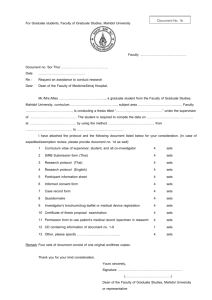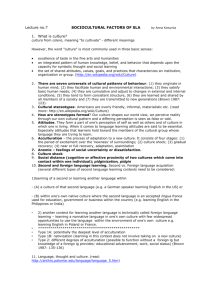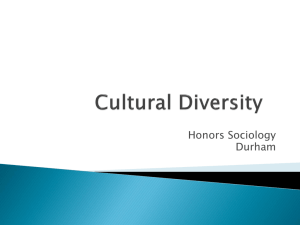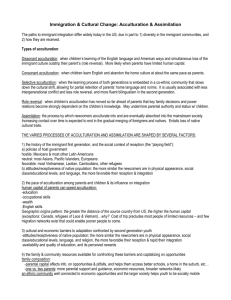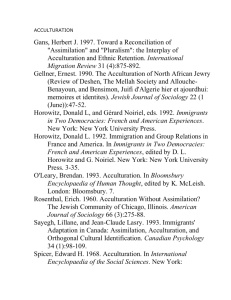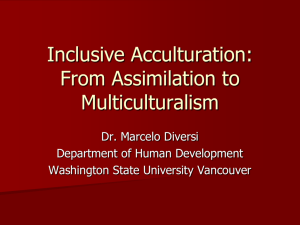A HIERARCHICAL MULTIPLE REGRESSION ANALYSIS OF
advertisement
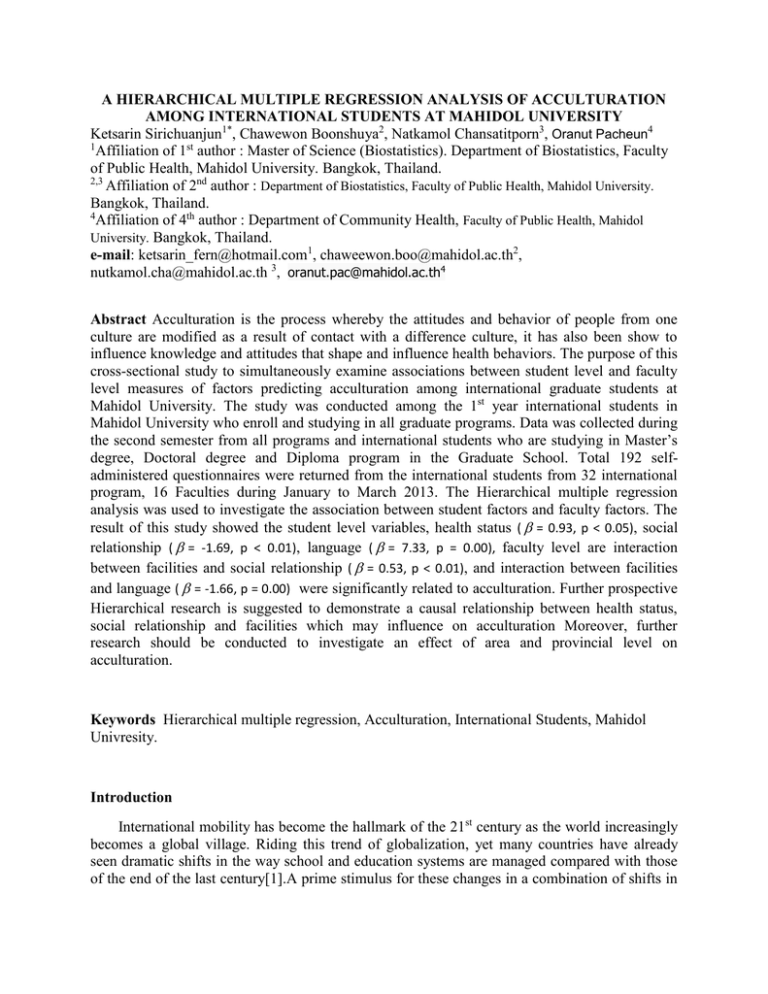
A HIERARCHICAL MULTIPLE REGRESSION ANALYSIS OF ACCULTURATION AMONG INTERNATIONAL STUDENTS AT MAHIDOL UNIVERSITY Ketsarin Sirichuanjun1*, Chawewon Boonshuya2, Natkamol Chansatitporn3, Oranut Pacheun4 1 Affiliation of 1st author : Master of Science (Biostatistics). Department of Biostatistics, Faculty of Public Health, Mahidol University. Bangkok, Thailand. 2,3 Affiliation of 2nd author : Department of Biostatistics, Faculty of Public Health, Mahidol University. Bangkok, Thailand. 4 Affiliation of 4th author : Department of Community Health, Faculty of Public Health, Mahidol University. Bangkok, Thailand. e-mail: ketsarin_fern@hotmail.com1, chaweewon.boo@mahidol.ac.th2, nutkamol.cha@mahidol.ac.th 3, oranut.pac@mahidol.ac.th4 Abstract Acculturation is the process whereby the attitudes and behavior of people from one culture are modified as a result of contact with a difference culture, it has also been show to influence knowledge and attitudes that shape and influence health behaviors. The purpose of this cross-sectional study to simultaneously examine associations between student level and faculty level measures of factors predicting acculturation among international graduate students at Mahidol University. The study was conducted among the 1st year international students in Mahidol University who enroll and studying in all graduate programs. Data was collected during the second semester from all programs and international students who are studying in Master’s degree, Doctoral degree and Diploma program in the Graduate School. Total 192 selfadministered questionnaires were returned from the international students from 32 international program, 16 Faculties during January to March 2013. The Hierarchical multiple regression analysis was used to investigate the association between student factors and faculty factors. The result of this study showed the student level variables, health status ( = 0.93, p < 0.05), social relationship ( = -1.69, p < 0.01), language ( = 7.33, p = 0.00), faculty level are interaction between facilities and social relationship ( = 0.53, p < 0.01), and interaction between facilities and language ( = -1.66, p = 0.00) were significantly related to acculturation. Further prospective Hierarchical research is suggested to demonstrate a causal relationship between health status, social relationship and facilities which may influence on acculturation Moreover, further research should be conducted to investigate an effect of area and provincial level on acculturation. Keywords Hierarchical multiple regression, Acculturation, International Students, Mahidol Univresity. Introduction International mobility has become the hallmark of the 21st century as the world increasingly becomes a global village. Riding this trend of globalization, yet many countries have already seen dramatic shifts in the way school and education systems are managed compared with those of the end of the last century[1].A prime stimulus for these changes in a combination of shifts in society, including greater migration, changes in social and family structures, and the use of information and communications technologies. Therefore the influential is a greatest emphasis on global village are the relative performance of each schools and education systems between school, school systems and countries to develop to be the same one[2]. Education is an important factor to human resource development and it is the key to national development. Every country attempts to expand the coverage of education and to reduce the inequality of education. Thailand is a country that expands opportunity for education to everyone. All of the university in Thailand includes public universities and private universities develop the international courses to be accepted of foreigner. Thailand is one of the 10-member Associations of South East Asian Nations (ASEAN). The ASEAN Vision 2015 aims to create a stable, prosperous and highly competitive ASEAN economic region, in which there is a free flow of goods, services, investment and capital, equitable economic development and reduced poverty and socio-economic disparities. The ASEAN Socio-Cultural Community envisages Southeast Asia bonded together in partnership as a strong community of caring societies and aimed at the vigorous development of regional identity and the preservation of the region's cultural heritage. To prepare each country’s work force for economic integration, ASEAN will encourage investment in education, training, science and technology development, job creation, and social protection. ASEAN will also seek increased cooperation in public health, especially the prevention and control of infectious and communicable diseases[3]. In Thailand, Office of the National Economic and Social Development Board has drafted the Direction of the Eleventh Plan with the participation of all stakeholders at community, regional, and national levels. The Plan was proposed to the Cabinet for the progress of the preparation on the 26th October 2010.Along with the Sufficiency Economy Philosophy, the framework of the Eleventh Plan is set to be driven under the people-centered development and broad base participation approaches towards balanced, integrated, and holistic development in order to the agreed vision of “a happy society with equity, fairness and resilience”. Over the five decades, the National Development Plans have uplifted Thailand to an advanced developing country with better income, quality of life, longevity, and education[4]. In 2013,Office of the Higher Education Commission reported at the meeting in March, that there were 20,115 foreign students studying in Thai higher educational institutions in 2011. Mainly they were from China, Myanmar, Laos, Vietnam and Cambodia, the most common universities are Assumption University, Mahidol University, Chulalongkorn University , Mission College and Thammasat University, respectively[5]. Mahidol University (MU) was founded in 1888 as School of Medical Practitioners, Siriraj Hospital and reorganized in 1943 as University of Medical Sciences. The university originally focused on Health Sciences and expanded to other fields in recent decades. MU hosted the first medical school of Thailand, the Siriraj Medical School, from which the university traced its origin. MU offers a wide range of graduate (most are international programs) and undergraduate programs from natural sciences to liberal arts with remote campuses in Nakhon Sawan. In 2002, MU expanded its campus to Kanchanaburi to offer its students more learning opportunities with rural communities. The university is expanded its campus to Amnaj-Chareon Province, in the Northeastern of Thailand in 2009. Then it became the largest university in Asia. MU entered the Quacquarelli Symonds World University Rankings in 2006 as 322nd in the world and 3rd in Thailand. In 2010, the university swiftly proceeded to the 228th in the world, 28th in Asian and as Thailand's top-ranked university according to Quacquarelli Symonds 2010 Asian Ranking, although some foreign ranking sources may provide different ranking.In 2010, according to University Ranking by Academic Performance (URAP) it is the best university in Thailand and 351st university in the world[6]. Mahidol University was officially founded on February 7, 1943 and experienced drastic growth since then. Many new schools and departments were established during this era. The oldest of the three Bangkok campuses, Bangkok Noi Campus is located on 28 acres (12 hectares) and is home to the original medical school attached to Siriraj Hospital, founded by H.M. King Chulalongkorn( King Rama the fifth) of Thailand in 1890 which over time become to be Mahidol University. The campus has retained its academic focus on medicine, revolving around the Siriraj Hospital complex. In 1959, the Medical Science Preparatory School (now Faculty of Science) was moved to Payathai area - thus beginning the Payathai campus. King Bhumipol( King Rama the ninth) expressed his will that MU should also expand to the fields of Social Science, so the Faculty of Social Sciences and Humanities was founded in 1969. The construction of Salaya campus began in 1975.Due the political situation and financial shortage it took 8 years for construction. On July 23, 1983, the Salaya campus was officially opened. All education for freshman-year students was transferred to Salaya. Later academic developments of the university tended to deviate from traditional Health Science area to facilitate academic demands of the country and later developments were centered on the Salaya campus[6]. In the academic year 2008, Mahidol University offered total of 371 programs, which comprised of 138 undergraduate programs and 233 post graduate program. Graduate Study Programs in the Academic Year 2008 were Graduate Diploma 51 programs, Master’s degree 160 programs, Higher graduate diploma 4 programs and Doctoral degree 66 programs. From 2004 to 2008, number of international graduate students was increasing from 222 to 401[7].It could be seen that the trend of international graduate students is increasing about 45per year. In 2008, number of international graduate students in the Academic Graduate Diploma, Master’s degree and Doctoral degree were 34, 282 and 85, respectively[7]. Acculturation is the process whereby the attitudes and/or behaviors of people from one culture are modified as a result of contact with a difference culture. The acculturation process affects a range of behaviors, value, and beliefs. Acculturation has also been shown to influence knowledge and attitudes that shape and influence health behaviors[8].Psychologists have considered the effects of self-concealment, social support, academic stressors, gender, English fluency, etc. on acculturative stress[9]. Psychosocial outcomes are therefore an essential aspect of school adjustment that, indirectly, may also become important to academic achievement[10].If they cannot adjust from those factors, they will increase stress, associated with lower level of anxiety and depression and with a poor quality of life, that is the major course in suicide[11-14]. Factors which may influence on acculturations among international can be classified into individual factors and program management factors in which an international student nested in the program. To identify an effect of both individual and program factors on acculturation, hierarchical multiple regression analysis will be applied. A hierarchical modeling is a statistics structure of unit of analysis where it is presented. Hierarchical refers to units grouped at different levels, for example international students grouped in a program level. The technique is used to determine how the structures affect the measurement of interest. It helps to determine better estimate than single level analysis[15]. The advantage of a multilevel model is that it is not only accommodate the hierarchical nature of data and corrects the estimated standard error to allow for clustering of observations within unit[16], but it also allows the identifications of clustering in the outcome. A hierarchical modeling is considerable variability in acculturate at program level seen among international graduate students which approach account for this source of variation to obtain more precise estimates of the effect of international student characteristics in each program. At the same time, by including program management level variables, it allows for estimation of the effect of program on acculturation. Methodology A hierarchical multiple regression analysis was used in this cross-sectional selfadministered questionnaire study to identify determinants of acculturation among MU International Graduate students. Study design A self-administered cross-sectional descriptive study was conducted to measure studentlevel factors: sex, age, marital status, length of stay, smoking, drinking, religion, experience of going abroad, language, degree, stress management, social relation, health status and programlevel factors: student-teacher ratio, facilities, program management, activities and location that may influence acculturation of MU International Graduate students. Population and sample The study was conducted among international students in Mahidol University who enroll and studying in all graduate programs. Data was collected during the second semester from all programs and international students there are 204 in 2012 international students from 36 programs who are studying in Master’s degree, Doctoral degree and Diploma program in the Graduate School. Inclusion and Exclusion Criteria Inclusion Criteria: International students who enroll for Master’s degree, Doctoral degree and Diploma Program in academic year 2012 at the Faculty of Graduate Studies who agree and sign the consent form to participate in this study. The Director of each International Master’s degree Program, Doctoral degree Program and Diploma Program of the Faculty of Graduate Studies in academic year 2012 who agree and sign the consent form to participate in this study. Exclusion Criteria: International students who enroll for Master’s degree, Doctoral degree and Diploma Program in academic year 2012 at the Faculty of Graduate Studies who are absent from university at the time of data collection, disagree and do not sign the consent form to participant in this study and desire for stop answering questionnaire while the interview. The Director of each International Master’s degree Program, Doctoral degree Program and Diploma Program of the Faculty of Graduate Studies in academic year 2012 who disagree at the time of data collection and do not sign the consent form to participant in this study. Data Collection Method of data collection Self-administered questionnaire as construct by the researcher based upon the conceptual framework and operational definition of term use. Permission for data collection of each international program was obtained from both Program Director and international students before data collection. Program Directors and international students were explained on the objectives and significance of the study until they are clearly understood. Objectives and significance of the study as well as risk and benefit were also explained to international students until all of them are clearly understood. If they agree to participate in the study, ask them to sign the inform consent form. The questionnaires will be handed to those who agree to participate and ask them to answer questions accordingly. The data collections were done by researcher and colleagues who were graduate students of the Master of Science in Biostatistics, Mahidol University, after obtaining an ethical clearance an ethic committee of the Faculty of public Health, Mahidol University. Research instrument A self-administered survey questionnaire was reviewed from researcher and selected some part of the National Latino and Asian American Study (NLAAS)[17] and The Student Adaptation to College Questionnaire( SACQ) by Robert W. Baker, Ph.D. and Bohdan Siryk, M.A[18], and was adjusted to appropriate with purpose of thesis field by thesis adviser and coadvisers. Questions was constructed base on the Roy’s Adaptation Model. There are two sets of data collection forms, one program director in various faculties of MU. Results The cross-sectional study aimed at assessing acculturation in the first-year international students. The data took collection in the second semester, on January to March 2013 and its related factors was conducted in Mahidol University. Total of 204 self-administered questionnaires were take all the international students representatives systematically and 192 were returned with the response rate 94.1% as shown in Table 1 Table 1 General Characteristics of 192 International Students at Mahidol University Table 1 (cont.) Characteristics Characteristics Number Percent Sex Male Female 108 56.3 84 43.7 Private 68 35.4 Partially sponsor 28 14.6 Fully sponsor 96 50.0 4 2.1 188 97.9 20-29 90 46.9 English 30-39 70 36.5 Others 40 up 32 16.6 S.D. (year) Min-Max (years) No 43 22.4 6.75 Yes 149 77.6 No 133 69.3 Yes 59 30.7 No 164 85.4 Yes 28 14.6 160 83.3 Ever smoke 18 9.4 Currently smoke 14 7.3 102 53.1 84 43.8 6 3.1 25 13.0 118 61.5 49 25.5 Exclusively Thai food 24 12.5 Mostly Thai food 47 24.4 84.4 Equally Thai and local food 46 24.0 27 14.1 Mostly local food 57 29.7 3 1.5 Exclusively local food 18 9.4 Exclusively Thai food 32 16.7 Mostly Thai food 62 32.3 Equally Thai and local food 49 25.5 Mostly local food 38 19.8 Exclusively local food 11 5.7 Experience in abroad 21 - 56 Buddhist 100 52.1 Christian 29 15.1 Islam 28 14.6 Others 35 18.2 Single 96 51.1 Divorced 3 1.6 Married 89 47.3 Rent house or apartment University’s dorm Others 5 2.6 157 81.8 27 14.1 3 1.5 ≤3 12 6.2 4-6 24 12.4 123 64.3 33 17.1 Participated degree Doctoral degree Certificate No Yes, occasionally Yes, frequently Exercise No Length of stay in Thailand (months) Master's degree Non-smoking Alcohol Current place of living Relatives' house Health problem Current Smoking status Marital status 10 - 12 Work experience 31.75 Religion 7-9 Percent Mother tongue language Age (years) Mean (years) Number Sponsor 162 Yes, occasionally Yes, frequently Food preference at home/dorm Food preference in restaurants Table 2 Parameter estimates in Hierarchical Multiple Regression Model Estimated coefficient Model 2 Model 3 96.81 (12.09) 83.78 (0.13) 99.39 (40.27) 0.88*(0.13) 0.86*(0.13) 0.93*(0.45) social relationship 0.33 (0.22) 0.27 (0.22) -1.69*(0.79) age status (single§) 0.13 (0.19) 0.21 (0.19) -0.56 (0.59) divorce -8.59 (8.23) -10.54 (8.28) -15.89 (8.68) married 1.63 (2.50) 0.86 (2.46) -3.39 (8.01) language 1.05*(0.46) 1.09*(0.52) 7.33*(1.72) length in Thailand 0.21 (0.58) 0.44 (0.52) 1.87 (2.18) degree sex (male§) 3.81 (3.08) 4.40 (3.06) 12.24 (9.68) female -1.42 (2.14) -1.54 (2.13) -6.04 (7.65) -1.61 (2.33) -1.54 (2.50) 0.40 (5.79) 0.71 (5.60) 2.98*(0.99) -1.43 (10.53) Effect Fix effect Intercept Model 0 177.12 (2.08) Model 1 Acculturation student Level health status Faculty3Level Campus (Salaya§) Phayathai Siriraj Facilities Interaction Facilities*health status -0.03 (0.12) Facilities*social relationship 0.53*(0.20) Facilities*age 0.19 (0.15) Facilities*status 0.61 (0.97) Facilities*language -1.66*(0.44) Facilities*length -0.30 (0.44) Facilities*degree -2.25 (2.37) Facilities*sex 1.00 (1.89) Random effect 2 0 5.13 3.18 0.00 0.00 766.23 727.09 723.21 712.55 Deviance 1532.45 1454.17 1446.42 1425.09 AIC 1538.45 1478.17 1476.42 1471.09 BIC 1548.03 1516.49 1524.31 1544.53 -2 Log likelihood Note : § Reference group , * p<.05, 2 0 variance among Faculties. The first Hierarchical multiple regression analysis was used to test the fit of the random intercept or null model (model 0). The model was fitted with no independent variable. The intercept estimated was 177.12 .This model provided an intra-class correlation (ICC) which was used to investigate faculty differences in individual acculturation status. In this step, random variation between faculty was significantly identified at p-value< 0.001. An estimated intra-class correlation ( ) was 0.0869 suggesting that 8.69% of the variability in acculturation status of individual lies among faculty. Model 1 demonstrated the effect of student-level factors on acculturation. Fitting model process began with an empty model and sequentially added the most predictive variable. The student-level variable with the strongly significant LR test was determined as candidate variable for hierarchical multilevel regression analysis in structuring the best model to predict acculturation status. The selection of student-level factors procedure proceeded until all variables has been evaluated and re-evaluated until the model reached at all student-level factors were significantly provided to the model, using likelihood ratio (LR) test to evaluate the model for each step. After added the variable into the model, it was found a reduction of the intercept from null model. The intercept estimated was 96.81. For the model 2, it was sequentially added all significant faculty-level factors related to acculturation status from univariate regression analysis. Model 1 with the student-level factors that significantly predicted their acculturation was used as baseline model and then added all variables of faculty-level were added into model 2. The intercept estimated was 83.78. The last model, it was sequentially added all significant interaction between faculty-level factors and student-level factors base on model 2. After added the variable into the model, it was found a reduction of the intercept from model 3. The intercept estimated was 99.39. Discussion and Conclusion The cross-sectional study was performed among 192 international students, among those responded to the self-administered questionnaire, 56.3% was male. Their age ranged from 21- 56 years old with an average of 32 years old. Regarding marital status, 51.1% was single. Considering their length of stay in Thailand, 64.4% was stayed in Thailand on the ranged from 79 months. Current of their living, 81.8% were rented house or apartment. For education level, 84.4% was Master’s degree and half of international students was gotten the fully sponsor. Mother tongue language of them, 97.9% was not English, 77.6% was have no work experience and 69.3% was have no experience in abroad before study in Graduate Studies. About their health problem, 85.4% was having no health problem. Current smoking status, 88.3% were nonsmoking. Current alcohol status, 53.1% were non-alcohol. Health care status, 61.5% were occasionally exercised. Food for daily life living, 29.7% made their local food at home/dorm and 32.3% eaten Thai food in the restaurants. Among 16 faculties recruited into this study, There were 3 campus; Salaya, Phayathai and Siriraj ,66.8% of faculties were in Salaya Campus. Work load ratio, 66.8% non-workload of Student-Teacher Ratio. The total number in each faculties ranged from 1-45 persons with an average 11 persons. Currently facilities for student, 56.2% in ranged score from 13-15. All activities, 43.7% in ranged score from 23-25. Score of program management, 50% in ranged score from 10-12. The Hierarchical multiple regression analysis to investigate the association between student factors and faculty factors, the model fitting process started with an empty model. This was the first Hierarchical multiple regression which was fitted with no variable; this model provided an intra-class correlation (ICC) indicating that 8.69% of the score of acculturation of respondents lies among faculty level, then it indicates that we need not consider the level in representing the variance of the outcome. Next step, the effect of both student-level and facultylevel characteristics on score of acculturation was considered to be included to the model 2. This model show a statistically significantly, they were health status, language and facilities were significantly related to acculturation. The last step, added all significant interaction between student-level factors and faculty-level factors. After added the variable into the model, this variable are significantly, health status, social relationship, language and interaction between facilities and social relationship were significantly related to acculturation (all p-value<0.05). It was found a reduction of the intercept from model 2. Therefore, the final model could be represented as; acculturation = 99.39 + 0.93 (health status) - 1.69 (social relationship) + 7.33 (language) + 0.53 (facilities*social relationship) – 1.66 (facilities*language) Further prospective Hierarchical research is suggested to demonstrate a causal relationship between health status, social relationship and facilities which may influence on acculturation Moreover, further research should be conducted to investigate an effect of area and provincial level on acculturation. References 1. 2. 3. 4. 5. 6. 7. 8. 9. 10. 11. 12. 13. 14. 15. 1 The Presidential Commission on Education Reform (1995) Education Reform for the 21st Century To Ensure Leadership in the Information and Globalization Era. 2 Education in the 21st Century. 2012 [cited 2012 14 March]; Available from: http://www.21stcenturyschools.com/What_is_21st_Century_Education.htm 3 Association of Southeast Asian Nations. 2012 [cited 2012 14 March]; Available from: http://actrav.itcilo.org/actrav-english/telearn/global/ilo/blokit/asean.htm. 4 Minister, O.o.t.P., Summary of the Direction of the Eleventh National Development Plan, O.o.t.N.E.a.S.D. Broad, Editor. 2010. 5 Commission, O. o. t. H. E. (2013). Foreign Students in Thai Higher Education Institutions 2010. 6 About Mahidol University. 2012 [cited 2012 14 March]; Available from: http://www.mahidol.ac.th/mueng/about.htm. 7 Facts and Figures. . 2012 [cited 2012 14 March]; Available from: http://www.grad.mahidol.ac.th/grad/aboutus/facts_en.php. 8 Cengage., E., "acculturation" Encyclopedia of public Health. 2002. 9 Constantine, M.G., S. Okazaki, and S.O. Utsey, Self-Concealment, Social Self-Efficacy, Acculturative Stress, and Depession in African, Asian, and Latin American international College Students. American Journal of Orthopsychiatry, 2004. 74(3): p. 230-241. 10 Diehl, D.S., et al., Peer relations and school adjustment in ungraded primary children. Journal of Educational Psychology, 1998. 90: p. 506-515. 11 Ang, R.P. and V.S. Huan, Relationship between Academic Stress and Suicadal Ideation: Testing for Depression as a Mediator Using Multiple Regression. Child Psychiatry Hum Dev, 2006. 37: p. 133-143. 12 Wilburn, V.R. and D.E. Smith, Stress,Self-esteem, and suicidal ideation in late adolescents. ADOLESCENCE, 2005. 40(157). 13 Chiou, P.-N., Y.-S. Chen, and Y.-C. Lee, Characteristics of Adolescent Suicide Attempters Admitted to an Acute Psychiatric Ward in Taiwan. Journal of the Chinese Medical Association, 2006. 69(9): p. 428-435. 14 Willis, L.A., et al., Ready to die: a postmodern interpretation of the increase of African-American adolescent male suicide. Social Science &amp; Medicine, 2002. 55(6): p. 907-920. 15 Goldstein, H. Multilevel statistic. . 2012 [cited 2012 14 March]; Available from: http://www.soziologie.unihalle.de/langer/multilevel/books/goldstein.pdf. 16. 16 Goldstein, H., Multilevel statistical model. 2003, London: a number of the Hodder Headline Group 17. 17 Lueck, K. and M. Wilson, Acculturative stress in Latino Immigrants: The impact of social, sociopsychological and migration-related factors. International Journal of Intercultural Relations, 2011. 35(2): p. 186-195. 18. 18 Baker., R.W. and B. Siryk., The Student Adaptation to College Questionnaire (SACQ). 1989.
